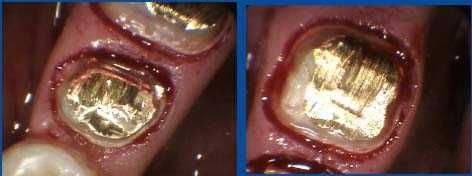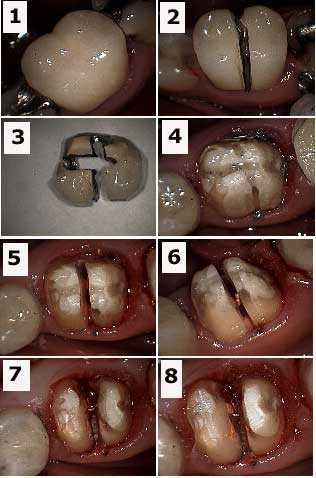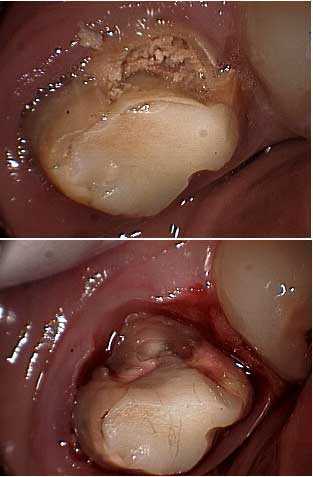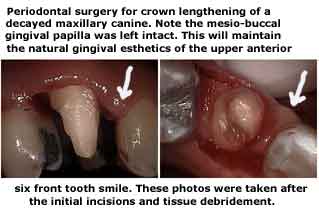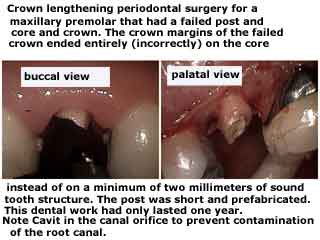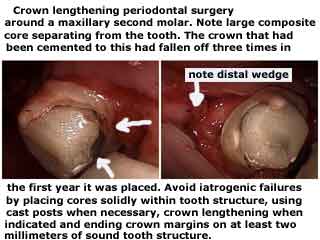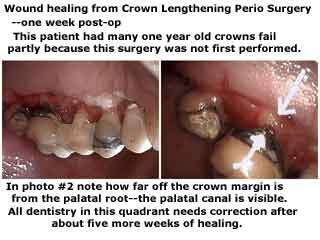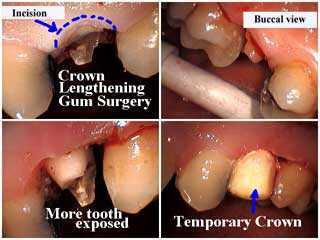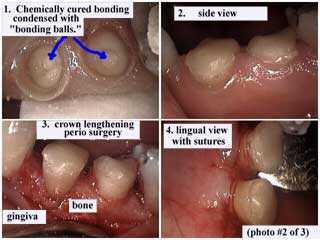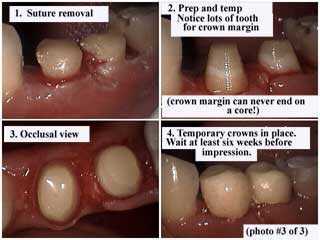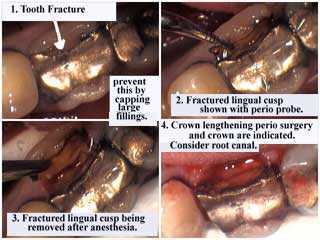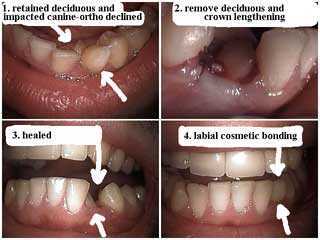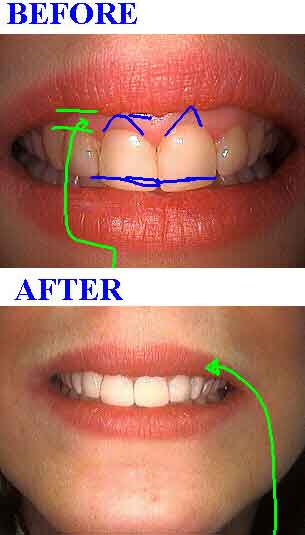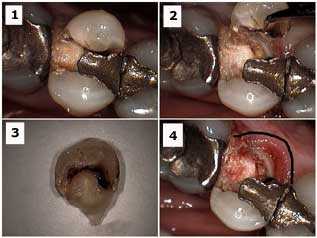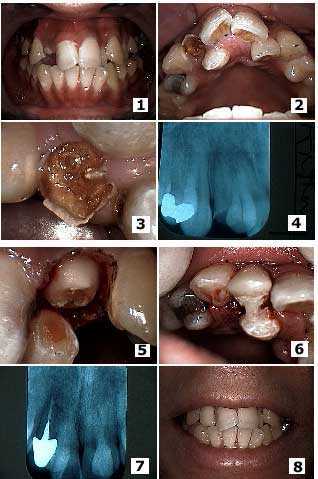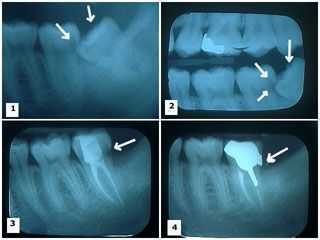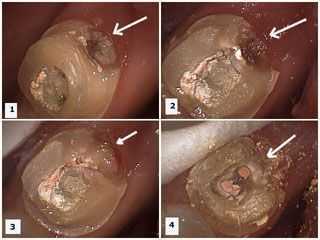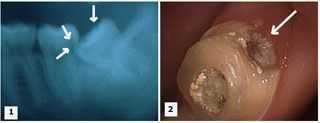Before and after photos on crown lengthening periodontal gum surgery performed in our Gum Disease Treatment office.
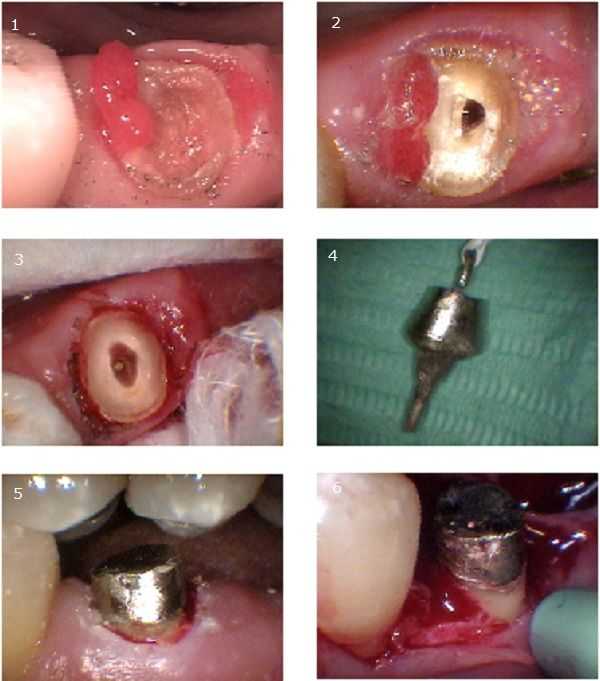
Crown lengthening – periodontal gum surgery – was performed in photo #6. Photo #1 – following crown removal this tooth had decay (cavity) below the gum. Note the gingival hyperplasia. The “oatmeal-like” consistency of the tooth is the decay. Photo #2 – root canal therapy was performed. Photo #3 – the root canal was reshaped into an oval to prevent rotation of the cast post & core. Note the gutta percha in the apical extent of the root canal. A gingivectomy was also performed to allow a clean impression for the cast post & core. Photo #4 – the cast post & core with a Kaitlyn Loop. Dental floss tied through the Kaitlyn Loop will help prevent accidental swallowing of the post & core. Photo #5 – following cementation of the cast post and core. Note the interocclusal clearance. Photo #6 – A marginal incision was made on buccal aspect and a 4 mm submarginal incision was made on the lingual. A distal wedge was removed.
Interproximal soft tissue was removed and then 1-2 mm of osseus resection was performed on the mesial, distal, and lingual aspects of the tooth. It was later sutured with 4-0 chromic gut. A temporary crown was placed and then periodontal packing was placed last.
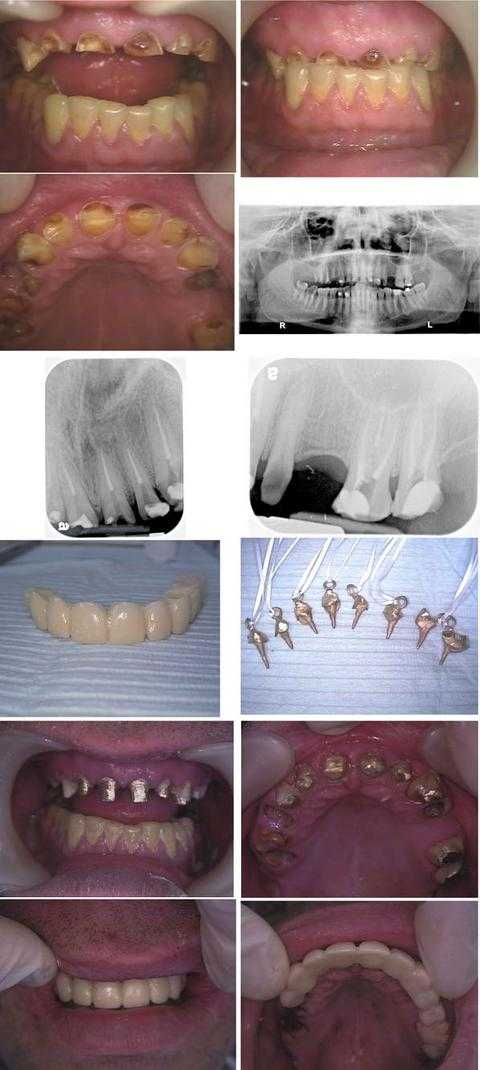
Oral Rehabilitation of a dental fear patient. Total treatment time was about nine hours in two visits during one business week: Monday (four hours) and Friday (five hours). This patient hid his dental condition for over a decade by never smiling.
In the first row of photos, note that the bite was overclosed due to a prior history of a bulimia, now controlled, and a current teeth grinding habit.
An Oral Surgeon consultation with panoramic x-ray (second row) was performed prior to treatment to evaluate opening the bite.
The third row shows x-rays taken after the Endodontist completed root canal on eight teeth on the first day of treatment on tooth #’s: 6 – 11 and 14, 15.
The fourth row shows a dental lab processed 11 tooth provisional dental bridge and the cast gold post/cores (with Kaitlyn loops) for the root canal treated teeth.
The fifth row shows the cast gold post/cores after being inserted with dental cement.
The sixth row shows the lab processed provisional dental bridge in place after the Oral Surgeon extracted tooth #’s: 3 – 5 and 12, crown lengthening gum surgery was performed on tooth #’s: 6 – 11, and a distal wedge was performed on #15.
The patient will have a final porcelain teeth bridge made after the gums heal. Dental implants may also be placed in the upper right posterior. A bite plate is also necessary to try to mitigate the force of tooth grinding. Referral for pharmacological management of anxiety is also worthwhile.
Why perform crown lengthening gum surgery? Tooth #13 has been left exposed for over a year since the root canal temporary filling fell out. 1. Current x-ray. 2. Buccal photo. 3. Palatal photo. 4. Occlusal photo. Treatment options: Extraction and then tooth replacement or retreat the root canal, post and core, crown lengthening gum surgery and crown. The gum surgery is needed to gain access to healthy tooth for rebuilding.
Diagnosis and treatment considerations for crown lengthening gum surgery. Two cast gold post and cores. The distal margin of the tooth on the left went subgingival, but not so deep that crown lengthening was necessary in that area. I chose to end the crown margin on the gold casting – in the distal only!! On the tooth on the right I chose to end the crown margin in the more typical manner, which is on two millimeters of healthy tooth structure. Sometimes rules can be broken if logic dictates.
Pictures show how to remove a dental tooth crown and resect a tooth – hemisection. 1) Pre-op dental crown. 2) Initial preparation through crown. 3) Crown after removal. 4) Tooth after crown removal. 5) Preparation through composite core. 6) Root canal filling material, gutta percha (orange color), is visible in this photo. 7) Hemisection completed. 8) Gutta percha is exposed and requires more dental composite to seal it within the tooth after crown lengthening periodontal gum surgery.
Tooth decay – cavity – should be removed before referring the patient for crown lengthening periodontal gum surgery so the periodontist knows how much osseous reduction – bone removal – is necessary.
Short clinical teeth crowns that require crown lengthening gum surgery to increase retention for the maxillary anterior bridge. Short clinical crowns means that there is not much tooth structure above the gum line for dental crowns and/or teeth bridges to cement to for adequate retention. 1) and 2) A three millimeter submarginal incision was made around all the teeth. 3) The gingival collar was removed including the interproximal tissue. 4) The flap was sutured against the underlying bone.
Tooth crown fractures in the upper anterior present a cosmetic challenge if the patient has a high lip line like that seen in these pictures. Extraction may be the best cosmetic choice if crown lengthening periodontal surgery is needed. If attempted, crown lengthening gum surgery should focus on obtaining tooth stucture from the palatal to compensate for limited labial gingival reduction. Failure will usually occur in a labial direction.
Periodontal gum surgery for crown lengthening of a decayed maxillary canine showing significant tooth decay. The mesio-buccal gingival papilla was left intact for cosmetic reasons. Note: “These photos were taken after the initial incisions and tissue debridement.”
Crown lengthening gum periodontal surgery for a maxillary premolar tooth that had a failed post and core, and dental crown. This surgery provided more healthy tooth structure to build a crown on. Note: “Note Cavit in the canal orifice to prevent contamination of the root canal.”
Gum surgery, crown lengthening periodontal surgery around a maxillary second molar tooth. This was needed to obtain more healthy tooth structure to rebuild this tooth. A large, failing dental composite buildup core is also shown separating from the tooth. This dentistry was only one year old. Note: “…crown lengthening when indicated and ending crown margins on at least two millimeters of sound tooth structure.”
These pictures show one week after gum surgery for crown lengthening periodontal surgery. Note: last line reads “…about five more weeks of healing.”
Why is gum surgery sometimes needed? Crown lengthening gum surgery is performed to gain more healthy tooth structure to attach all that is necessary to rebuild it. Note: words in bottom right corner read “Temporary Crown.”
Dental bonding condensed with bonding balls. Teeth require crown lengthening for more tooth — crown margins should NEVER end on a core! Note: word in bottom left corner reads “gingiva.”
Before and after pictures – crown lengthening periodontal gum surgery.
Placing dental crown – tooth caps – over large dental fillings will help prevent vertical teeth fractures and other possible fractures below the gum line.
The labial surface of this tooth received dental bonding to close the teeth gap after extraction of the baby tooth and gum healing.
Before and after pictures show how to reduce a gummy smile with crown lengthening periodontal surgery. Porcelain veneers were placed on the four upper front teeth six weeks after the gum surgery healed. Office teeth whitening was also performed. Note that the gummy smile partially caused by a high lip line has been eliminated.
Subgingival tooth fractures need crown lengthening periodontal gum surgery. 1) The entire lingual cusp of this upper premolar fractured and can be seen separated from the tooth decay around the silver dental filling. 2) The lingual cusp is being lifted away from the tooth. 3) The fractured cusp of the tooth. 4) The tooth after the removal of the fractured cusp. The black line indicates the anticipated extent of crown lengthening periodontal surgery that will be necessary.
Need for crown lengthening. Treatment of a broken, decayed upper lateral incisor adjacent to a palatally-displaced supernumerary tooth. Images 1) – 2) Initial presentation. Note the broken, decayed lateral and the palatal location of the adjacent supernumerary tooth. Image 3) Close up of the broken, decayed lateral and the adjacent palatally-displaced supernumerary tooth. Image 4) X-ray. 5) The same tooth after electrosurgery – gum surgery – and initial tooth drilling. 6) Placement of the provisional tooth. Note that acrylic was extended from the temporary on the lateral to the supernumerary tooth to provide initial stability of the temporary until root canal therapy and a cast post and core was placed. 7) Radiograph of the final root canal therapy, cast post and core and dental crown. 8) Final result.
X-rays show the reason for wisdom tooth extraction: damage to the adjacent second molar. 1) – 2) Two x-rays showing a lower wisdom tooth impacted on an angle and pushing into the adjacent second molar causing a large cavity. 3) X-ray shows the wisdom tooth was removed and the second molar following root canal therapy with the large distal cavity still present. Note that in this case the initial healing gum around the extraction site was low enough around the adjacent second molar so that crown lengthening gum surgery was NOT needed! 4) Cast gold post and core and crown in place. Note the distal crown margin completely covered where the distal cavity was removed.
Rationale for wisdom tooth extraction: damage to the adjacent second molar. These images show drilling the second molar tooth to remove the distal cavity after root canal therapy was performed on it and the wisdom tooth was removed. 1) – 2) Tooth decay is present in the distal area of the second molar. Temporary filling material is visible in the occlusal opening following root canal therapy. 3) Decay removed. 4) Temporary filling material removed showing gutta percha in root canal orifices prior to cast post and core preparation.
Note that in this case the initial healing gum around the extraction site was low enough around the adjacent second molar so that crown lengthening gum surgery was NOT needed!
Reason for wisdom tooth extraction: avoiding damage to the adjacent second molar. 1) X-ray showing a lower wisdom tooth impacted on an angle and pushing into the adjacent second molar causing a large dental cavity. 2) Tooth decay is present in the distal area of the second molar. Temporary filling material is visible in the occlusal opening following root canal.



